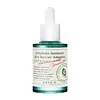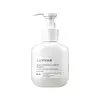What's inside
What's inside
 Key Ingredients
Key Ingredients

 Benefits
Benefits

 Concerns
Concerns

No concerns
 Ingredients Side-by-side
Ingredients Side-by-side

Water
Skin ConditioningAloe Barbadensis Leaf Water
MaskingButylene Glycol
HumectantSodium Hyaluronate
HumectantCentella Asiatica Extract
CleansingGlycerin
HumectantBetaine
HumectantPropanediol
SolventGlycyrrhiza Uralensis Root Extract
Skin ConditioningHieracium Umbellatum Extract
Skin ConditioningCynara Scolymus Leaf Extract
Skin ConditioningSorbitol
HumectantAloe Barbadensis Leaf Extract
EmollientDioscorea Japonica Root Extract
Skin ConditioningLaminaria Japonica Extract
Skin Protecting1,2-Hexanediol
Skin ConditioningXanthan Gum
EmulsifyingCarbomer
Emulsion StabilisingLinum Usitatissimum Seed Extract
PerfumingHibiscus Esculentus Fruit Extract
Skin ConditioningAloe Barbadensis Leaf Juice
Skin ConditioningArctium Lappa Root Extract
Skin ConditioningHibiscus Mutabilis Flower Extract
Skin ConditioningCorchorus Olitorius Leaf Extract
Skin ConditioningRheum Palmatum Root Extract
AstringentAlthaea Rosea Flower Extract
Skin ConditioningDimethyl Sulfone
SolventChlorphenesin
AntimicrobialEthylhexylglycerin
Skin ConditioningPolyglutamic Acid
Skin ConditioningBeta-Glucan
Skin ConditioningArginine
MaskingAllantoin
Skin ConditioningAdenosine
Skin ConditioningWater, Aloe Barbadensis Leaf Water, Butylene Glycol, Sodium Hyaluronate, Centella Asiatica Extract, Glycerin, Betaine, Propanediol, Glycyrrhiza Uralensis Root Extract, Hieracium Umbellatum Extract, Cynara Scolymus Leaf Extract, Sorbitol, Aloe Barbadensis Leaf Extract, Dioscorea Japonica Root Extract, Laminaria Japonica Extract, 1,2-Hexanediol, Xanthan Gum, Carbomer, Linum Usitatissimum Seed Extract, Hibiscus Esculentus Fruit Extract, Aloe Barbadensis Leaf Juice, Arctium Lappa Root Extract, Hibiscus Mutabilis Flower Extract, Corchorus Olitorius Leaf Extract, Rheum Palmatum Root Extract, Althaea Rosea Flower Extract, Dimethyl Sulfone, Chlorphenesin, Ethylhexylglycerin, Polyglutamic Acid, Beta-Glucan, Arginine, Allantoin, Adenosine
Water
Skin ConditioningGlycerin
HumectantCocamidopropyl Betaine
CleansingLauryl Glucoside
CleansingCoco-Glucoside
CleansingXanthan Gum
EmulsifyingCitric Acid
BufferingParfum
MaskingGlyceryl Caprylate
EmollientLactobacillus Ferment Lysate
Skin ConditioningDisodium EDTA
Ethylhexylglycerin
Skin ConditioningButylene Glycol
HumectantLactic Acid
BufferingPanax Ginseng Root Water
Masking1,2-Hexanediol
Skin ConditioningBupleurum Chinense Root Extract
AstringentAngelica Acutiloba Root Extract
Skin ConditioningOphiopogon Japonicus Root Extract
Skin ConditioningTocopherol
AntioxidantWater, Glycerin, Cocamidopropyl Betaine, Lauryl Glucoside, Coco-Glucoside, Xanthan Gum, Citric Acid, Parfum, Glyceryl Caprylate, Lactobacillus Ferment Lysate, Disodium EDTA, Ethylhexylglycerin, Butylene Glycol, Lactic Acid, Panax Ginseng Root Water, 1,2-Hexanediol, Bupleurum Chinense Root Extract, Angelica Acutiloba Root Extract, Ophiopogon Japonicus Root Extract, Tocopherol
 Reviews
Reviews

Ingredients Explained
These ingredients are found in both products.
Ingredients higher up in an ingredient list are typically present in a larger amount.
1,2-Hexanediol is a synthetic liquid and another multi-functional powerhouse.
It is a:
- Humectant, drawing moisture into the skin
- Emollient, helping to soften skin
- Solvent, dispersing and stabilizing formulas
- Preservative booster, enhancing the antimicrobial activity of other preservatives
Butylene Glycol (or BG) is used within cosmetic products for a few different reasons:
Overall, Butylene Glycol is a safe and well-rounded ingredient that works well with other ingredients.
Though this ingredient works well with most skin types, some people with sensitive skin may experience a reaction such as allergic rashes, closed comedones, or itchiness.
Learn more about Butylene GlycolEthylhexylglycerin (we can't pronounce this either) is commonly used as a preservative and skin softener. It is derived from glyceryl.
You might see Ethylhexylglycerin often paired with other preservatives such as phenoxyethanol. Ethylhexylglycerin has been found to increase the effectiveness of these other preservatives.
Glycerin is already naturally found in your skin. It helps moisturize and protect your skin.
A study from 2016 found glycerin to be more effective as a humectant than AHAs and hyaluronic acid.
As a humectant, it helps the skin stay hydrated by pulling moisture to your skin. The low molecular weight of glycerin allows it to pull moisture into the deeper layers of your skin.
Hydrated skin improves your skin barrier; Your skin barrier helps protect against irritants and bacteria.
Glycerin has also been found to have antimicrobial and antiviral properties. Due to these properties, glycerin is often used in wound and burn treatments.
In cosmetics, glycerin is usually derived from plants such as soybean or palm. However, it can also be sourced from animals, such as tallow or animal fat.
This ingredient is organic, colorless, odorless, and non-toxic.
Glycerin is the name for this ingredient in American English. British English uses Glycerol/Glycerine.
Learn more about GlycerinWater. It's the most common cosmetic ingredient of all. You'll usually see it at the top of ingredient lists, meaning that it makes up the largest part of the product.
So why is it so popular? Water most often acts as a solvent - this means that it helps dissolve other ingredients into the formulation.
You'll also recognize water as that liquid we all need to stay alive. If you see this, drink a glass of water. Stay hydrated!
Learn more about WaterXanthan gum is used as a stabilizer and thickener within cosmetic products. It helps give products a sticky, thick feeling - preventing them from being too runny.
On the technical side of things, xanthan gum is a polysaccharide - a combination consisting of multiple sugar molecules bonded together.
Xanthan gum is a pretty common and great ingredient. It is a natural, non-toxic, non-irritating ingredient that is also commonly used in food products.
Learn more about Xanthan Gum